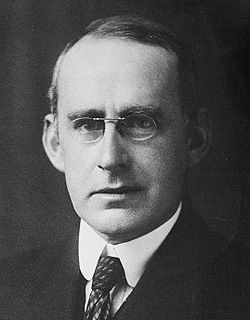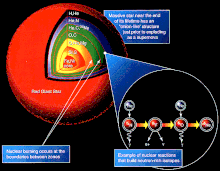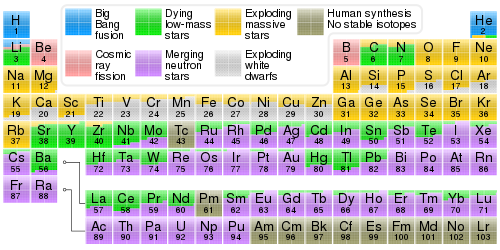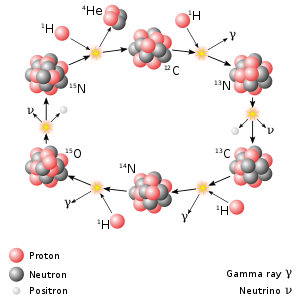Stellar nucleosynthesis
Stellar nucleosynthesis is the theory explaining the creation (nucleosynthesis) of chemical elements by nuclear fusion reactions between atoms within the stars. Stellar nucleosynthesis has occurred continuously since the original creation of hydrogen, helium and lithium during the Big Bang. It is a highly predictive theory that today yields excellent agreement between calculations based upon it and the observed abundances of the elements. It explains why the observed abundances of elements in the universe grow over time and why some elements and their isotopes are much more abundant than others. The theory was initially proposed by Fred Hoyle in 1946,[1] who later refined it in 1954.[2] Further advances were made, especially to nucleosynthesis by neutron capture of the elements heavier than iron, by Margaret Burbidge, Geoffrey Burbidge, William Alfred Fowler and Hoyle in their famous 1957 B2FH paper,[3] which became one of the most heavily cited papers in astrophysics history.
Stars evolve because of changes in their composition (the abundance of their constituent elements) over their lifespans, first by burning hydrogen (main sequence star), then helium (red giant star), and progressively burning higher elements. However, this does not by itself significantly alter the abundances of elements in the universe as the elements are contained within the star. Later in its life, a low-mass star will slowly eject its atmosphere via stellar wind, forming a planetary nebula, while a higher–mass star will eject mass via a sudden catastrophic event called a supernova. The term supernova nucleosynthesis is used to describe the creation of elements during the evolution and explosion of a pre-supernova massive star (12–35 times the mass of the sun). Those massive stars are the most prolific source of new isotopes from carbon (Z = 6) to nickel (Z = 28).
The advanced sequence of burning fuels is driven by gravitational collapse and its associated heating, resulting in the subsequent burning of carbon, oxygen and silicon. However, most of the nucleosynthesis in the mass range A = 28–56 (from silicon to nickel) is actually caused by the upper layers of the star collapsing onto the core, creating a compressional shock wave rebounding outward. The shock front briefly raises temperatures by roughly 50%, thereby causing furious burning for about a second. This final burning in massive stars, called explosive nucleosynthesis or supernova nucleosynthesis, is the final epoch of stellar nucleosynthesis.
A stimulus to the development of the theory of nucleosynthesis was the discovery of variations in the abundances of elements found in the universe. The need for a physical description was already inspired by the relative abundances of isotopes of the chemical elements in the solar system. Those abundances, when plotted on a graph as a function of atomic number of the element, have a jagged sawtooth shape that varies by factors of tens of millions (see history of nucleosynthesis theory).[4] This suggested a natural process that is not random. A second stimulus to understanding the processes of stellar nucleosynthesis occurred during the 20th century, when it was realized that the energy released from nuclear fusion reactions accounted for the longevity of the Sun as a source of heat and light.[5]
History

In 1920, Arthur Eddington, on the basis of the precise measurements of atomic masses by F.W. Aston and a preliminary suggestion by Jean Perrin, proposed that stars obtained their energy from nuclear fusion of hydrogen to form helium and raised the possibility that the heavier elements are produced in stars.[6][7][8] This was a preliminary step toward the idea of nucleosynthesis. In 1928, George Gamow derived what is now called the Gamow factor, a quantum-mechanical formula that gave the probability of bringing two nuclei sufficiently close for the strong nuclear force to overcome the Coulomb barrier. The Gamow factor was used in the decade that followed by Atkinson and Houtermans and later by Gamow himself and Edward Teller to derive the rate at which nuclear reactions would proceed at the high temperatures believed to exist in stellar interiors.
In 1939, in a paper entitled "Energy Production in Stars", Hans Bethe analyzed the different possibilities for reactions by which hydrogen is fused into helium[9]. He defined two processes that he believed to be the sources of energy in stars. The first one, the proton–proton chain reaction, is the dominant energy source in stars with masses up to about the mass of the Sun. The second process, the carbon–nitrogen–oxygen cycle, which was also considered by Carl Friedrich von Weizsäcker in 1938, is more important in more massive main-sequence stars. These works concerned the energy generation capable of keeping stars hot. A clear physical description of the proton–proton chain and of the CNO cycle appears in a 1968 textbook[5]. Bethe's two papers did not address the creation of heavier nuclei, however. That theory was begun by Fred Hoyle in 1946 with his argument that a collection of very hot nuclei would assemble thermodynamically into iron[1]. Hoyle followed that in 1954 with a large paper describing how advanced fusion stages within massive stars would synthesize the elements from carbon to iron in mass[2]. This is the first work of stellar nucleosynthesis[10]. It and Hoyle's 1954 paper provided the roadmap to how the most abundant elements on Earth had been synthesized within stars from their initial hydrogen and helium, making clear how those abundant elements increased their galactic abundances as the galaxy aged.
Hoyle's theory was expanded to other processes, beginning with the publication of a review paper in 1957 by Burbidge, Burbidge, Fowler and Hoyle (commonly referred to as the B2FH paper).[3] This review paper collected and refined earlier research into a heavily cited picture that gave promise of accounting for the observed relative abundances of the elements; but it did not itself enlarge Hoyle's 1954 picture for the origin of primary nuclei as much as many assumed, except in the understanding of nucleosynthesis of those elements heavier than iron by neutron capture. Significant improvements were made by Alastair G. W. Cameron and by Donald D. Clayton. Cameron presented his own independent approach[11] (following Hoyle's approach for the most part) of nucleosynthesis. He introduced computers into time-dependent calculations of evolution of nuclear systems. Clayton calculated the first time-dependent models of the S-process[12] and of the R-process,[13] as well as of the burning of silicon into the abundant alpha-particle nuclei and iron-group elements,[14][15] and discovered radiogenic chronologies[16] for determining the age of the elements. The entire research field expanded rapidly in the 1970s.

Key reactions

The most important reactions in stellar nucleosynthesis:
- Hydrogen fusion:
- Helium fusion:
- The triple-alpha process
- The alpha process
- Fusion of heavier elements:
- Lithium burning: a process found most commonly in brown dwarfs
- Carbon-burning process
- Neon-burning process
- Oxygen-burning process
- Silicon-burning process
- Production of elements heavier than iron:
- Neutron capture:
- Proton capture:
- The Rp-process
- The P-process
- Photodisintegration
Hydrogen fusion
Hydrogen fusion (nuclear fusion of four protons to form a helium-4 nucleus[17]) is the dominant process that generates energy in the cores of main-sequence stars. It is also called "hydrogen burning", which should not be confused with the chemical combustion of hydrogen in an oxidizing atmosphere. There are two predominant processes by which stellar hydrogen fusion occurs: proton-proton chain and the carbon-nitrogen-oxygen (CNO) cycle. Ninety percent of all stars, with the exception of white dwarfs, are fusing hydrogen by these two processes.
In the cores of lower-mass main-sequence stars such as the Sun, the dominant energy production process is the proton–proton chain reaction. This creates a helium-4 nucleus through a sequence of chain reactions that begin with the fusion of two protons to form a deuterium nucleus (one proton plus one neutron) along with an ejected positron and neutrino.[18] In each complete fusion cycle, the proton–proton chain reaction releases about 26.2 MeV.[18] The proton–proton chain reaction cycle is relatively insensitive to temperature; a 10% rise of temperature would increase energy production by this method by 46%, hence, this hydrogen fusion process can occur in up to a third of the star's radius and occupy half the star's mass. For stars above 35% of the Sun's mass,[19] the energy flux toward the surface is sufficiently low and energy transfer from the core region remains by radiative heat transfer, rather than by convective heat transfer.[20] As a result, there is little mixing of fresh hydrogen into the core or fusion products outward.
In higher-mass stars, the dominant energy production process is the CNO cycle, which is a catalytic cycle that uses nuclei of carbon, nitrogen and oxygen as intermediaries and in the end produces a helium nucleus as with the proton-proton chain.[18] During a complete CNO cycle, 25.0 MeV of energy is released. The difference in energy production of this cycle, compared to the proton–proton chain reaction, is accounted for by the energy lost through neutrino emission.[18] The CNO cycle is very temperature sensitive, a 10% rise of temperature would produce a 350% rise in energy production. About 90% of the CNO cycle energy generation occurs within the inner 15% of the star's mass, hence it is strongly concentrated at the core.[21] This results in such an intense outward energy flux that convective energy transfer become more important than does radiative transfer. As a result, the core region becomes a convection zone, which stirs the hydrogen fusion region and keeps it well mixed with the surrounding proton-rich region.[22] This core convection occurs in stars where the CNO cycle contributes more than 20% of the total energy. As the star ages and the core temperature increases, the region occupied by the convection zone slowly shrinks from 20% of the mass down to the inner 8% of the mass.[21] Our Sun produces 10% of its energy from the CNO cycle.
The type of hydrogen fusion process that dominates in a star is determined by the temperature dependency differences between the two reactions. The proton–proton chain reaction starts at temperatures about 4×106 K,[23] making it the dominant fusion mechanism in smaller stars. A self-maintaining CNO chain requires a higher temperature of approximately 16×106 K, but thereafter it increases more rapidly in efficiency as the temperature rises, than does the proton-proton reaction.[24] Above approximately 17×106 K, the CNO cycle becomes the dominant source of energy. This temperature is achieved in the cores of main sequence stars with at least 1.3 times the mass of the Sun.[25] The Sun itself has a core temperature of about 15.7×106 K. As a main sequence star ages, the core temperature will rise, resulting in a steadily increasing contribution from its CNO cycle.[21]
Helium fusion
Main sequence stars accumulate helium in their cores as a result of hydrogen fusion, but the core does not become hot enough to initiate helium fusion. Helium fusion first begins when a star leaves the red giant branch after accumulating sufficient helium in its core to ignite it. In stars around the mass of the sun, this begins at the tip of the red giant branch with a helium flash from a degenerate helium core and the star moves to the horizontal branch where it burns helium in its core. More massive stars ignite helium in their cores without a flash and execute a blue loop before reaching the asymptotic giant branch. Despite the name, stars on a blue loop from the red giant branch are typically not blue in color, but are rather yellow giants, possibly Cepheid variables. They fuse helium until the core is largely carbon and oxygen. The most massive stars become supergiants when they leave the main sequence and quickly start helium fusion as they become red supergiants. After helium is exhausted in the core of a star, it will continue in a shell around the carbon-oxygen core.[17][20]
In all cases, helium is fused to carbon via the triple-alpha process. This can then form oxygen, neon, and heavier elements via the alpha process. In this way, the alpha process preferentially produces elements with even numbers of protons by the capture of helium nuclei. Elements with odd numbers of protons are formed by other fusion pathways.
References
- ^ a b
Hoyle, F. (1946). "The synthesis of the elements from hydrogen". Monthly Notices of the Royal Astronomical Society. 106 (5): 343–383. Bibcode:1946MNRAS.106..343H. doi:10.1093/mnras/106.5.343.
{{cite journal}}: CS1 maint: unflagged free DOI (link) - ^ a b Hoyle, F. (1954). "On Nuclear Reactions Occurring in Very Hot STARS. I. The Synthesis of Elements from Carbon to Nickel". The Astrophysical Journal Supplement Series. 1: 121. Bibcode:1954ApJS....1..121H. doi:10.1086/190005.
- ^ a b Burbidge, E. M.; Burbidge, G. R.; Fowler, W.A.; Hoyle, F. (1957). "Synthesis of the Elements in Stars" (PDF). Reviews of Modern Physics. 29 (4): 547–650. Bibcode:1957RvMP...29..547B. doi:10.1103/RevModPhys.29.547.
- ^ Suess, H. E.; Urey, H. C. (1956). "Abundances of the Elements". Reviews of Modern Physics. 28 (1): 53–74. Bibcode:1956RvMP...28...53S. doi:10.1103/RevModPhys.28.53.
- ^ a b Clayton, D. D. (1968). Principles of Stellar Evolution and Nucleosynthesis. University of Chicago Press.
- ^ Eddington, A. S. (1920). "The internal constitution of the stars". The Observatory. 43: 341–358. Bibcode:1920Obs....43..341E.
- ^ Eddington, A. S (1920). "The Internal Constitution of the Stars". Nature. 106 (2653): 14. Bibcode:1920Natur.106...14E. doi:10.1038/106014a0.
- ^
Selle, D. (October 2012). "Why the Stars Shine" (PDF). Guidestar. Houston Astronomical Society. pp. 6–8. Archived from the original (PDF) on 2013-12-03.
{{cite web}}: Unknown parameter|deadurl=ignored (|url-status=suggested) (help) - ^ Bethe, H. A. (1939). "Energy Production in Stars". Physical Review. 55 (5): 434–456. Bibcode:1939PhRv...55..434B. doi:10.1103/PhysRev.55.434.
- ^ Clayton, D. D. (2007). "HISTORY OF SCIENCE: Hoyle's Equation". Science. 318 (5858): 1876–1877. doi:10.1126/science.1151167. PMID 18096793.
- ^ Cameron, A. G. W. (1957). Stellar Evolution, Nuclear Astrophysics, and Nucleogenesis (PDF) (Report). Atomic Energy of Canada. Report CRL-41.
- ^ Clayton, D. D.; Fowler, W. A.; Hull, T. E.; Zimmerman, B. A. (1961). "Neutron capture chains in heavy element synthesis". Annals of Physics. 12 (3): 331–408. Bibcode:1961AnPhy..12..331C. doi:10.1016/0003-4916(61)90067-7.
- ^ Seeger, P. A.; Fowler, W. A.; Clayton, D. D. (1965). "Nucleosynthesis of Heavy Elements by Neutron Capture". The Astrophysical Journal Supplement Series. 11: 121–126. Bibcode:1965ApJS...11..121S. doi:10.1086/190111.
- ^ Bodansky, D.; Clayton, D. D.; Fowler, W. A. (1968). "Nucleosynthesis During Silicon Burning". Physical Review Letters. 20 (4): 161–164. Bibcode:1968PhRvL..20..161B. doi:10.1103/PhysRevLett.20.161.
- ^ Bodansky, D.; Clayton, D. D.; Fowler, W. A. (1968). "Nuclear Quasi-Equilibrium during Silicon Burning". The Astrophysical Journal Supplement Series. 16: 299. Bibcode:1968ApJS...16..299B. doi:10.1086/190176.
- ^ Clayton, D. D. (1964). "Cosmoradiogenic Chronologies of Nucleosynthesis". The Astrophysical Journal. 139: 637. Bibcode:1964ApJ...139..637C. doi:10.1086/147791.
- ^ a b Jones, Lauren V. (2009), Stars and galaxies, Greenwood guides to the universe, ABC-CLIO, pp. 65–67, ISBN 978-0-313-34075-8
- ^ a b c d Böhm-Vitense, Erika (1992), Introduction to Stellar Astrophysics, vol. 3, Cambridge University Press, pp. 93–100, ISBN 978-0-521-34871-3
- ^ Reiners, A.; Basri, G. (March 2009). "On the magnetic topology of partially and fully convective stars". Astronomy and Astrophysics. 496 (3): 787–790. arXiv:0901.1659. Bibcode:2009A&A...496..787R. doi:10.1051/0004-6361:200811450.
- ^ a b de Loore, Camiel W. H.; Doom, C. (1992), Structure and evolution of single and binary stars, Astrophysics and space science library, vol. 179, Springer, pp. 200–214, ISBN 978-0-7923-1768-5
- ^ a b c Jeffrey, C. Simon (2010), "Stellar structure and evolution: an introduction", in Goswami, A.; Reddy, B. E. (eds.), Principles and Perspectives in Cosmochemistry, Springer, pp. 64–66, ISBN 978-3-642-10368-1
- ^ Karttunen, Hannu; Oja, Heikki (2007), Fundamental astronomy (5th ed.), Springer, p. 247, ISBN 978-3-540-34143-7
- ^ Reid, I. Neill; Hawley, Suzanne L. (2005), New light on dark stars: red dwarfs, low-mass stars, brown dwarfs, Springer-Praxis books in astrophysics and astronomy (2nd ed.), Springer, p. 108, ISBN 978-3-540-25124-8
- ^ Salaris, Maurizio; Cassisi, Santi (2005), Evolution of stars and stellar populations, John Wiley and Sons, pp. 119–123, ISBN 978-0-470-09220-0
- ^ Schuler, S. C.; King, J. R.; The, L.-S. (2009), "Stellar Nucleosynthesis in the Hyades Open Cluster", The Astrophysical Journal, 701 (1): 837–849, arXiv:0906.4812, Bibcode:2009ApJ...701..837S, doi:10.1088/0004-637X/701/1/837
Further reading
- Bethe, H. A. (1939). "Energy Production in Stars". Physical Review. 55 (1): 103. Bibcode:1939PhRv...55..103B. doi:10.1103/PhysRev.55.103.
- Bethe, H. A. (1939). "Energy Production in Stars". Physical Review. 55 (5): 434–456. Bibcode:1939PhRv...55..434B. doi:10.1103/PhysRev.55.434.
- Hoyle, F. (1954). "On Nuclear Reactions occurring in very hot stars: Synthesis of elements from carbon to nickel". Astrophysical Journal Supplement. 1: 121–146. Bibcode:1954ApJS....1..121H. doi:10.1086/190005.
- Clayton, Donald D. (1968). Principles of Stellar Evolution and Nucleosynthesis. New York: McGraw-Hill.
- Ray, A. (2004). "Stars as thermonuclear reactors: Their fuels and ashes". arXiv:astro-ph/0405568.
{{cite arXiv}}:|class=ignored (help) - G. Wallerstein; I. Iben Jr.; P. Parker; A.M. Boesgaard; G.M. Hale; A. E. Champagne; et al. (1997). "Synthesis of the elements in stars: forty years of progress" (PDF). Reviews of Modern Physics. 69 (4): 995–1084. Bibcode:1997RvMP...69..995W. doi:10.1103/RevModPhys.69.995. Archived from the original (PDF) on 2009-03-26. Retrieved 2006-08-04.
{{cite journal}}: Unknown parameter|deadurl=ignored (|url-status=suggested) (help) - Woosley, S. E.; A. Heger; T. A. Weaver (2002). "The evolution and explosion of massive stars". Reviews of Modern Physics. 74 (4): 1015–1071. Bibcode:2002RvMP...74.1015W. doi:10.1103/RevModPhys.74.1015.
- Clayton, Donald D. (2003). Handbook of Isotopes in the Cosmos. Cambridge: Cambridge University Press. ISBN 978-0-521-82381-4.
External links
- How the Sun Shines by John N. Bahcall
- Nucleosynthesis in NASA's Cosmicopia


